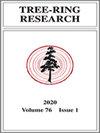交叉测定枯树:采样高度会影响结果吗?
IF 1.1
4区 农林科学
Q3 FORESTRY
引用次数: 1
摘要
在树木死前遭受胁迫时,生长可能部分或全部受到抑制,或者可能只发生在孔的上部。这可能导致对死树进行回顾性杂交测定时的不准确性。本文研究了4种北方针叶树的145个树干和原木的基部、胸高(BrH)和上部(UP)的交日盘的最后产环年(YOLRP)的发生情况和时间滞后范围。我们还评估了树木年龄和死亡前生长的影响。当比较树木上下部分的yrp时,超过一半的时间滞后偏离零。不同物种的平均滞后时间为0.6至4.6年,滞后时间最长可达14年。负时间滞后,即在井眼上部停止生产时,在井眼下部产生环,在高达26%的情况下也被观察到。我们建议,当重建精细的死亡率模式时,在必须优化精度的情况下,应考虑在BrH采样整个圆盘,以及在采样老树或缓慢下降的树木时在UP采样一个圆盘。本文章由计算机程序翻译,如有差异,请以英文原文为准。
Crossdating Dead Trees: Does Sampling Height Influence Results?
ABSTRACT In trees experiencing stress prior to death, growth may be partially or totally suppressed, or may occur only in the upper part of the boles. This may induce inaccuracies when retrospectively crossdating dead trees. In this study, we investigated the occurrence and range of time lags between year of last ring production (YOLRP) in crossdated discs collected at the base, at breast height (BrH), and in the upper part (UP) of the boles of 145 snags and logs of four boreal species. We also assessed the influence of tree age and growth prior to death. When comparing YOLRP in the upper and lower part of trees, more than half the time lags departed from zero. Mean lags ranged from 0.6 to 4.6 years according to species, with lags up to 14 years. Negative time lags, i.e. ring production occurring in the lower part of boles while it has stopped in the upper part, were also observed in up to 26% of cases. We suggest that when reconstructing fine patterns of mortality where accuracy must be optimized, sampling entire discs at BrH should be considered, as well as sampling a disc in the UP when sampling old or slowly declining trees.
求助全文
通过发布文献求助,成功后即可免费获取论文全文。
去求助
来源期刊

Tree-Ring Research
农林科学-林学
CiteScore
2.40
自引率
12.50%
发文量
15
审稿时长
>36 weeks
期刊介绍:
Tree-Ring Research (TRR) is devoted to papers dealing with the growth rings of trees and the applications of tree-ring research in a wide variety of fields, including but not limited to archaeology, geology, ecology, hydrology, climatology, forestry, and botany. Papers involving research results, new techniques of data acquisition or analysis, and regional or subject-oriented reviews or syntheses are considered for publication.
Scientific papers usually fall into two main categories. Articles should not exceed 5000 words, or approximately 20 double-spaced typewritten pages, including tables, references, and an abstract of 200 words or fewer. All manuscripts submitted as Articles are reviewed by at least two referees. Research Reports, which are usually reviewed by at least one outside referee, should not exceed 1500 words or include more than two figures. Research Reports address technical developments, describe well-documented but preliminary research results, or present findings for which the Article format is not appropriate. Book or monograph Reviews of 500 words or less are also considered. Other categories of papers are occasionally published. All papers are published only in English. Abstracts of the Articles or Reports may be printed in other languages if supplied by the author(s) with English translations.
 求助内容:
求助内容: 应助结果提醒方式:
应助结果提醒方式:


